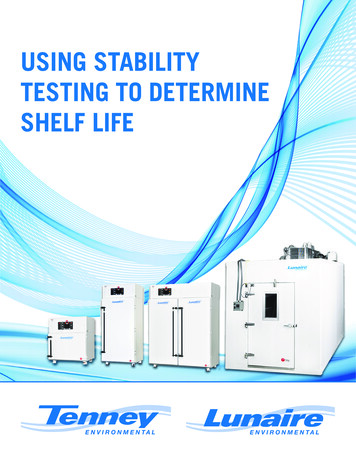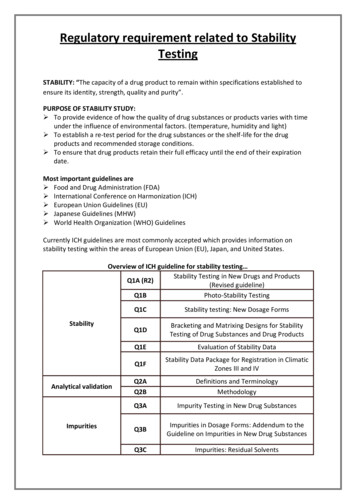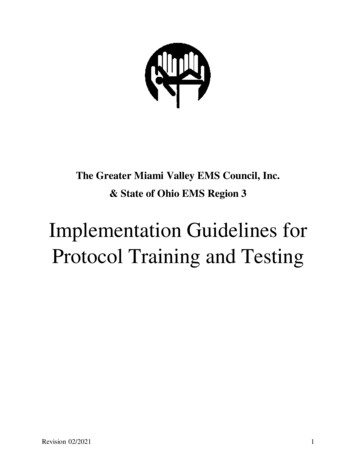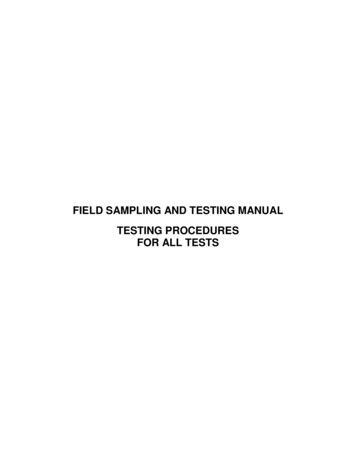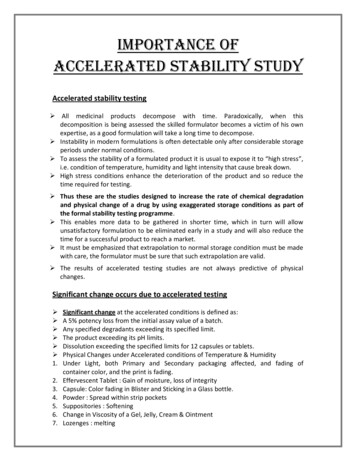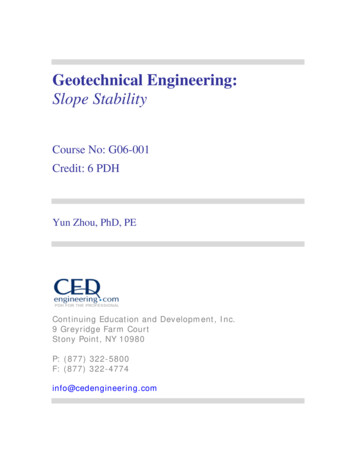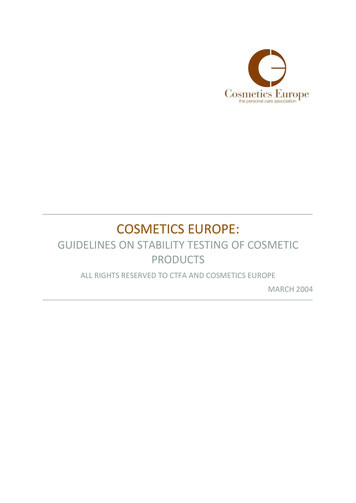
Transcription
COSMETICS EUROPE:GUIDELINES ON STABILITY TESTING OF COSMETICPRODUCTSALL RIGHTS RESERVED TO CTFA AND COSMETICS EUROPEMARCH 2004
03/094 - MCGUIDELINESON STABILITY TESTING OF COSMETIC PRODUCTSMarch 2004I. GENERAL CONSIDERATIONS1. INTRODUCTIONGeneralThe purpose of stability testing cosmetic products is to ensure that a new or modifiedproduct meets the intended physical, chemical and microbiological quality standardsas well as functionality and aesthetics when stored under appropriate conditions.Because the development cycle of cosmetic products is relatively short, and also, inorder that the testing activity does not become economically disproportionate in view ofthe multitude of product launches each year, each manufacturer must have at theirdisposal tests that are adapted to their activity. Each manufacturer should design theirstability testing program such that it is reasonable and efficiently addresses the testingrequired.This document aims to set out guidelines in order to predict and assure the stability ofproducts in the market place. Its purpose is to aid manufacturers of cosmetic productsin the selection and the refinement of the appropriate stability tests. Although thisguideline can provide a helpful starting point, it is important that manufacturerscarefully evaluate new products and technologies and, where appropriate, adapt theirtesting to reflect differences between product types and formulations.However, all methods assuring the final stability of a cosmetic product against thecategories cited in paragraph below, if it is at least equivalent to the recommendationsof the following chapters, are considered as valid. Procedures must be put in place anddocumented within the manufacturer’s internal system.1
03/094 - MCGeneral Stability of a Cosmetic ProductWhether conducted in real time or under accelerated conditions, tests should be donein order to assure: Stability and physical integrity of cosmetic products under appropriate conditions ofstorage, transport and use, Chemical stability, Microbiological stability, The compatibility between the contents and the container.Moreover, concerning methodology, the manufacturer should, for each formula type,select the pertinent criteria according to their experience and evaluate these at one ormore temperatures. The evolution of the test parameters should then be judged by thecorresponding expert and a decision made for each criterion on the basis of thecompany’s internal procedures and experience. An evaluation, based on all of thecriteria should then allow for the predicted or real stability of the product to bededuced.Because of the wide variety of cosmetic products and their inherent complexity,“standard” stability tests cannot be prescribed. Manufacturers, who have an intimateknowledge of their products and packages, require the flexibility to modify testingprotocols and to build a sound scientific basis for assessing product stability. Thus,specific tests may be developed in order to predict possible evolutions of the product,to address new/ unusual technologies, or to be adapted to products having extendedshelf lives.Accelerated Stability TestsAccelerated tests, developed because of the relatively short development cycle forcosmetic products, enable the prediction of stability. A commonly accepted practice isto support the forecasts obtained from accelerated stability testing by carrying outperiodic post-launch monitoring of retained samples stored at ambient temperatures.The resultant information can also be useful in further improving the product and inrefining the methodology used for accelerated stability testing.2. DESIGNING A COSMETIC STABILITY STUDYA stability study should include the following considerations (each of which will bediscussed in more detail later): Identify tests that will “accelerate and predict” the effects of normal conditions ofstorage and use.Where relevant, consider stresses, including temperature, that will enable assessmentof product integrity under anticipated product exposure conditions. Consider evaluation of critical aesthetic properties such as color, fragrance, texture,and flow, particularly after exposure to conditions designed to stress each specificproperty. Consider variation in process conditions. Consider the impact of packaging on the contained product, as well as any effectswhich the product might have on the packaging.2
03/094 - MC3. PREDICTING SHELF LIFEThere is very little generally-applicable published research to support specificaccelerated methods for predicting cosmetic shelf life. Some of the reasons for thislack of information are: The variety and complexity of cosmetic formulas and packaging. The proprietary nature of many products and stability test methods. The variety of types of changes that need to be examined, including p hysical,chemical, microbial, functional or aesthetic changes.“Accelerated” ConditionsAccelerated test conditions are internationally recognized as appropriately predictingproduct shelf life in many industries.Appropriate conditions, for example with regard to temperature and/or duration, shouldbe chosen according to the product category and the in-house know-how and shouldbe based on sound scientific judgment. Data acquired using various techniques atdifferent temperatures and durations can be used, possibly in conjunction with the useof mathematical models, to predict stability.Tests are often performed at 37 C, 40 C or 45 C during 1, 2, 3 months but thetemperature used and the duration will depend on the product type. For instance, forcertain product categories other temperatures may prove to be more useful.Based on the accelerated stability results and on its scientific experience, a companymay then be able to predict the actual stability for given market conditions.Scale-Up Stability TestingIn the early stages of product development, initial determinations of product stabilitycan be made by testing samples from laboratory batches under appropriate conditions.As development progresses, it may be necessary to make more precisedeterminations of probable stability by testing samples from batches manufacturedwith equipment representative of that which will be used to manufacture thecommercial product. Factors such as equipment type and configuration, process, batchsize and product type need to be considered when developing a stability program.Shade and Fragrance VariationsIt is advisable that stability tests include a representative range of shades and/orfragrances which are judged to represent the stability extremes of the product. If any ofthese extremes yield results which are unsatisfactory or questionable, additionalshades or fragrances should be tested.In certain circumstances, It may be advisable to test all fragrance variations, becausefragrances are more likely to interact with the product than are color shades. Also,some cosmetics come in so many shade variations that testing all shades would not bepractical.3
03/094 - MCPackagingPackaging can directly affect finished product stability because of interactions whichcan occur between the product, the package, and the external environment. Suchinteractions may include: Interactions between the product and the container (e.g. adsorption of productconstituents into the container, corrosion, chemical reactions, migration); Barrier properties of the container (its effectiveness in protecting the contents fromthe adverse effects of atmospheric oxygen and/or water vapor, and in ensuring theretention of water and other volatile product constituents).Stability testing should include packaging which is made of exactly the samematerial(s) and is as similar as possible in all other respects to the package in whichthe product will be marketed. If the product will be marketed in several differentpackage types, it is advisable to study each package type. Where there is a range ofpackage sizes, it is advisable to test the product in the smallest container. Appropriatecontrols (for example, product in glass containers) should be used. It may also beadvisable to test the packaged product in various orientations (upright, inverted, on itsside, etc.)Parameter variability during product shelf lifeWhen designing a stability test protocol, it is important to bear in mind that as productsage, their properties may change. Because of this fact, stability testing may need toinvolve testing of properties beyond those which will be evaluated for initial releasetesting. The assessment of the following criteria is given as an example and is neitherexhaustive nor a minimum requirement as the tests will depend on the productcategory and the packaging type:Ø Color, odor and appearance,Ø Changes in the container,Ø pH,Ø Viscosity,Ø Weight changesØ Microbial tests demonstrating the ability of the products to prohibit microbialgrowth during normal use and other specific tests if necessary,Ø Analytical data in relation to other parameters for specific product typesConfirmatory MonitoringAs a general rule, it is advisable to employ confirmatory (“real-time”) monitoring to gainadditional assurance that the accelerated testing is truly predictive of market stability.Such monitoring should be carried out on the actual production product in the finalpackage. Testing can be very simple (for example periodic visual monitoring ofproduction retains stored at ambient temperature), or it can be more complex(conducting stability studies of production retains under controlled temperatureconditions which parallel those used in the accelerated testing). Manufacturers mayconsider supplementing the information gained with such data as trade surveys andconsumer feedback.4
03/094 - MC4. PREDICTING FUNCTIONALITY UNDER STRESS CONDITIONSThis section describes approaches to predicting how well cosmetics will resist commonstresses such as temperature extremes and light. Typically, manufacturers determinewhether to perform such specialized testing based on the vulnerabilities of theparticular cosmetic product and its anticipated shipping, storage, display and useconditions.Temperature Variations and ExtremesTemperature cycling and/or “freeze-thaw” tests can reveal some types of inadequaciesmore quickly than can storage at a constant temperature. Freeze -thaw testing shouldbe considered for certain types of products.Examples of problems which can be detected by freeze-thaw testing includesuspension problems (a tendency to crystallize or cloud), instability of emulsions andcreams, package design issues (such as wrinkling or loss of labels, cracking ordistortion), corrosion of internal lacquers in aluminum tubes, etcAs products can be expected to encounter temperature and pressure extremes duringtransport and storage, stability testing at these extremes should be considered, forexample :Ø Low-temperature testing, as well as freeze/ thaw testing.Ø High-temperature testing.Mechanical and Physical TestsMechanical shock testing is often conducted in order to determine whether or notshipping movements may damage the cosmetic and/or its packaging. Vibration testingcan help to determine for example whether de-mixing (separation) of powders orgranular products is likely to occur.Light StabilityCosmetics whose packaging may allow the product to be exposed to light shouldundergo light stability testing. The lighting used in testing should simulate the intensityto which the cosmetic will likely be exposed.5
03/094 - MCII. DESIGNING A STABILITY STUDY: A PRACTICAL GUIDEGeneralThe following section outlines a logical approach to designing a stability study whichhighlights key considerations. In reality, however, it is most likely that companies willhave already set up programs for each product category based on their ownexperience (which would nevertheless fit with these principles). This step by stepreflection would therefore only be applied to totally novel products or by companiesperforming stability studies on a particular category of cosmetic products for the firsttime. Consider that throughout the design process the basic principle is to providedata that will assure that the product continues to fulfill its initial function and beof appropriate quality through the course of its intended usage. Consider the characteristics/specifications of the product and define clearlywhat will be considered as acceptable stability, as this may vary across the widerange of cosmetic products and will be dependent on each company’s internalprocedures and experience. Consider the points in the process where the appropriate level of confidencehas been reached. The fast cycle time for cosmetic products means that whileconfirmatory studies are continued a well-designed study should use experienceand scientific expertise to answer the key questions about product stability. Consider existing data on similar products with similar packaging.The study of past data may give indications as to what areas of product stabilitythe new program should focus to increase the effectiveness and efficacy of theprogram.Specific Considerations§Determine the parameters to be investigated in the study. These should berelevant to the product type, its specific formulation and package and shouldtake into account any specific legislative requirements. Not all parameters mayneed to be investigated at every sampling stage if this is reasonable based onexperience and scientific principle.§Determine the relevant conditions under which the product could be stored.These should reflect the normal expected exposure of the product during its lifecycle. In addition to testing product in the selected packaging, controls may beconsidered.Throughout their life cycle products may be exposed to a number of differentconditions during their storage, transport, retail and finally use by the consumer.A stability program should reflect the most likely conditions that will beexperienced and attempt to replicate them. Possible areas to be
PREDICTING SHELF LIFE There is very little generally-applicable published research to support specific accelerated methods for predicting cosmetic shelf life. Some of the reasons for this lack of information are: The variety and complexity of cosmetic formulas and packaging. The proprietary nature of many products and stability test methods. The variety of types of changes that .
